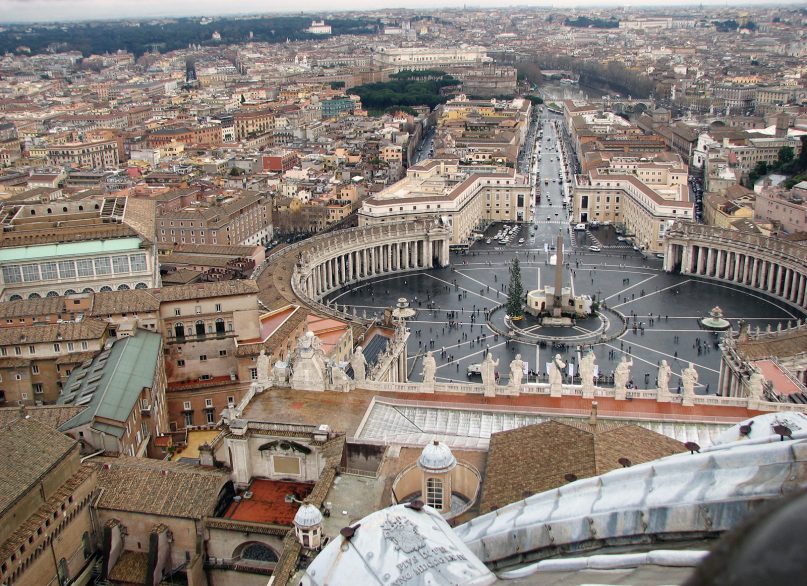VATICAN CITY (RNS) — On the final day of 2022, Pope Benedict XVI died, putting an end to a year already marked with challenges old and new at the Vatican, even as Pope Francis continues to steer the centuries-old institution amid growing polarization within the church and society.
From encouraging diplomacy between Russia and Ukraine to trying to reconcile the conservative and progressive factions tearing at the Catholic Church, Francis has attempted to be a bridge builder. But continuing sexual and financial scandals undermined the religious institution and raised questions about the efficacy and resolve of a pope who isn’t getting any younger.
The end of the era of two popes
The death of the retired Pope Benedict XVI on Dec. 31, 2022 put an end to the unique period of having two popes inside the Vatican walls. When Ratzinger resigned as pontiff in 2013 it sent ripples across the Catholic world and opened the door to entirely new scenarios within the church.
While Benedict and Pope Francis went to great lengths to underline the continuity between the two pontificates, the duality of having two white clad prelates at the Vatican created a never-before seen tension among faithful. Benedict represented a consoling figure for conservative-minded Catholics who were weary of Pope Francis’ openness to dialogue with the progressive demands of the modern world.
Benedict’s death realigned the focus of power on a single pope, but his resignation created a precedent that will change the church forever. After all, Benedict was an emeritus pope for longer than his reign as pontiff. Aging popes now have the option of stepping down, and despite its ups and downs, Francis and Benedict showed that the church can sustain the split reality of an active and contemplative pontificate.
Meanwhile, the year saw the first clear signs of Pope Francis’ declining physical health. The 86-year-old pontiff had to cancel Masses, processions, trips and events due to growing pain tied to the sciatica affecting his leg. In May, Pope Francis underwent a small operation on his leg, and on May 5 faithful saw the pontiff using a wheelchair for the first time.
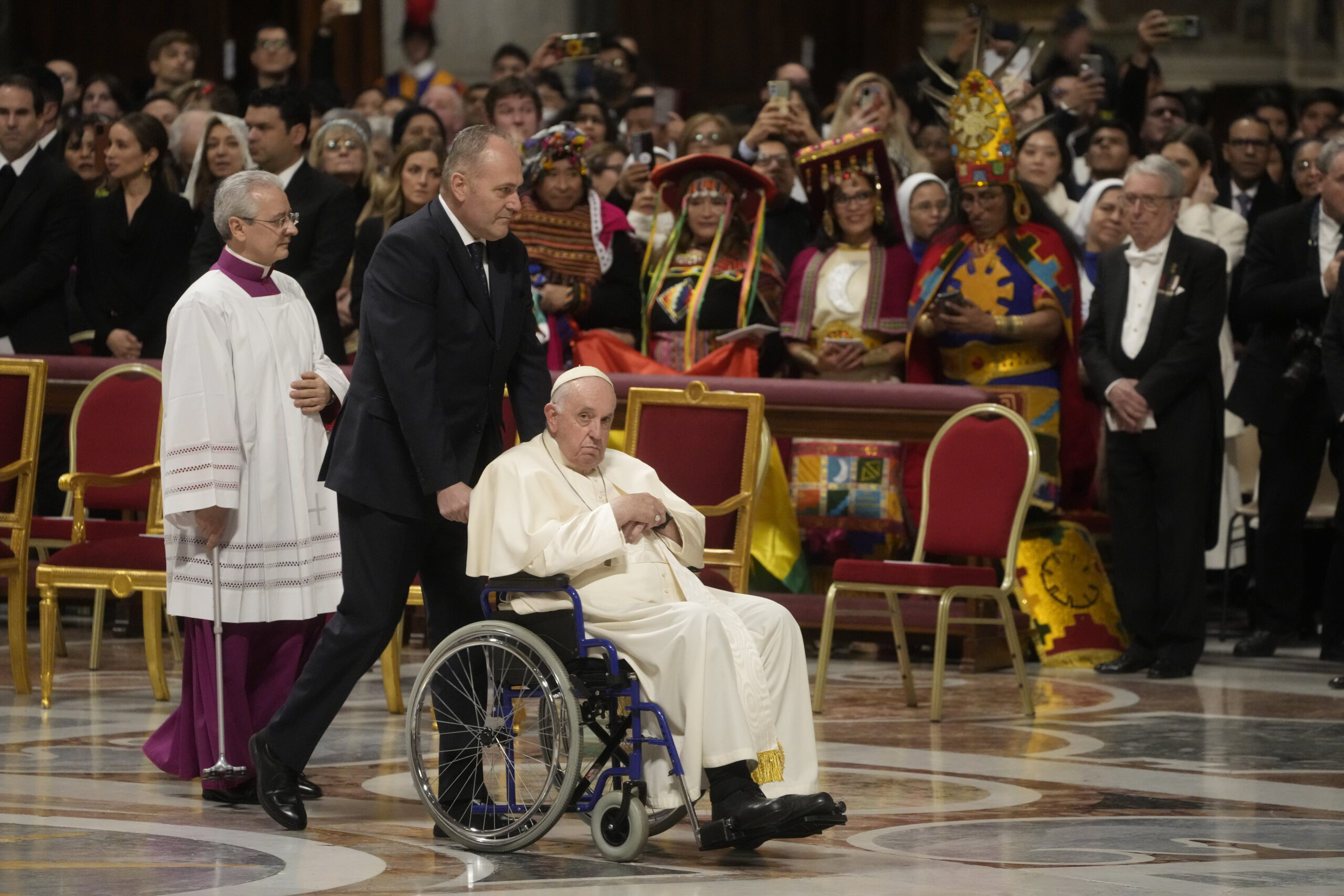
Pope Francis arrives in St. Peter’s Basilica at the Vatican to preside over a Mass in honor of Our Lady of Guadalupe, Dec. 12, 2022. (AP Photo/Gregorio Borgia)
When the Vatican announced in June that the pope’s scheduled trip to Congo and South Sudan was canceled because of the pope’s health issues, Vatican observers questioned whether the pontiff might be considering an early retirement. And on his return trip from visiting Canada in July, Francis said “the door is always open” to retire.
In an interview with the Spanish newspaper ABC this month, the pope said he has already signed his resignation should his health or a sudden accident make him incapable of performing his duties. Still, Francis shows no signs of slowing down as he prepares to visit two African countries Jan. 31–Feb. 5.
Calls for peace in Ukraine
When Russian forces invaded Ukraine on Feb. 22, Pope Francis broke protocol and rushed to the Russian Embassy to plead for peace with the ambassador, while reaching out to Ukrainian leaders. For months, the pope offered for the Vatican to mediate a peace between the warring countries.
The pope’s unwillingness to explicitly condemn Russia and its president, Vladimir Putin, drew criticism, but Francis insisted peace could only be restored through dialogue. He also pointed to foreign influences in the conflict and criticized NATO for “barking at Russia’s door.”
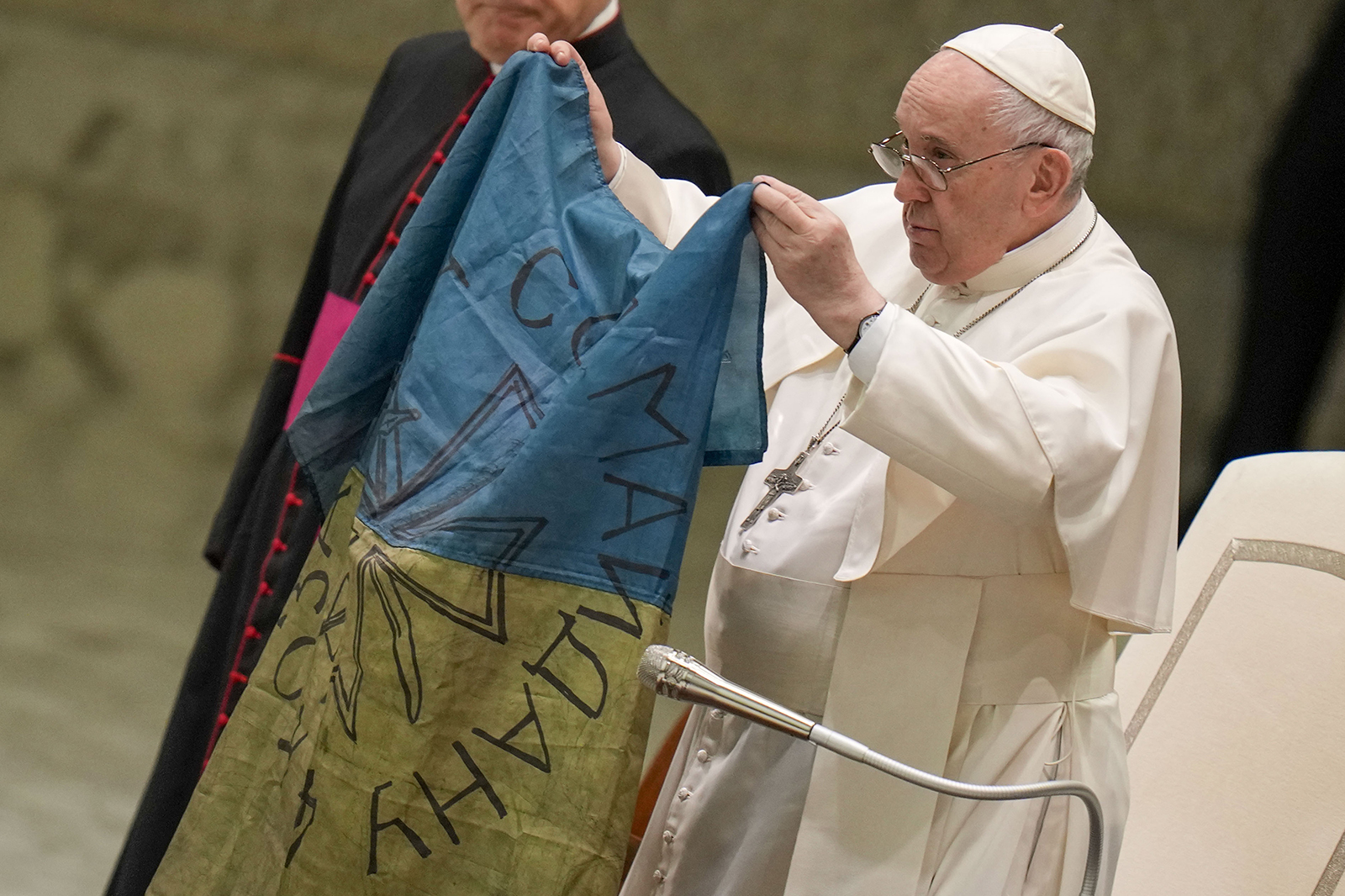
Pope Francis shows a flag that was brought to him from Bucha, Ukraine, during his weekly general audience in the Paul VI Hall, at the Vatican, April 6, 2022. (AP Photo/Alessandra Tarantino)
The Vatican and Pope Francis spent years trying to restore a tense relationship with the Orthodox Church in Russia and its leader, Patriarch Kirill of Moscow. But as Kirill’s outward support for Putin became evident, the pope warned him during an online meeting not to become “Putin’s altar boy.” Francis hoped to meet Kirill in person during an interreligious summit in Kazakhstan in September, but the patriarch did not attend.
With Vatican negotiations with Russia stalled, Pope Francis’ language concerning the war in Ukraine grew increasingly harsh, comparing Russia’s invasion to the Stalin-era famine. Meanwhile, the pope sent his closest allies — Archbishop Richard Gallagher, Cardinal Michael Czerny and Cardinal Konrad Krajewski — to Ukraine in a show of support.
2022 highlighted the challenges facing Vatican diplomacy not only with Russia, but also with China. A renewed agreement between China and the Vatican on the appointment of bishops struggled to bring tangible results as faithful still face persecution in the country, while drawing criticism from both the United States and the European Union.
Synodality in a polarized church
Pope Francis’ large-scale project to take the pulse of the Catholic Church across the globe launched in 2021 and entered its second phase this year. Evolving from vague concepts on ecclesiology and discernment, the Synod on Synodality is beginning to gain form as an effort to reform the role of bishops and the laity in the Catholic institution.
The ambitious project saw conservative and liberal Catholics face off over the prospect that the synod might do too much — or too little — to change the church. In the United States, a vocal conservative cohort within the bishops’ conference opposed Francis’ decision to apply strong limitations to the Latin Mass in the Old Rite.

Synod on Synodality logo. Courtesy image
When Speaker of the House Nancy Pelosi received Communion at the Vatican in the wake of the Supreme Court’s decision to overturn Roe v. Wade, it was interpreted as a sign that the pope was distancing himself from the politics of the Communion bans in the United States.
Meanwhile, a synodal path in Germany pulls at the Vatican from the left, calling for LGBTQ inclusion, female ordination and an overhaul of the church’s hierarchical structures. This year, the Vatican pulled the brakes on the German bishops by taking female ordination off the table and urging unity.
In October, Pope Francis announced the extension of the Synod on Synodality until 2024, as he attempts to straddle the tensions within the church. On the 60th anniversary of the Second Vatican Council, which attempted to reconcile the church with the secularized demands of the 1960s, Catholicism’s relationship with the modern world continued to be an uphill battle.
The continuing shadow of clerical abuse
The year began with a report, released by the German Archdiocese of Munich and Freising, showing that bishops in the diocese between 1945 and 2019, including the future Pope Benedict XVI, failed to report and punish clergy and laypeople accused of sexual abuse.
As the year progressed, clerical abuse scandals erupted in numerous parts of the world, especially in Europe, where the church has witnessed the most significant drops in Mass participation and priestly vocations. In France, 11 cardinals are under investigation for abuse, including Cardinal Jean-Pierre Ricard, who in November admitted to abusing a 14-year-old girl.
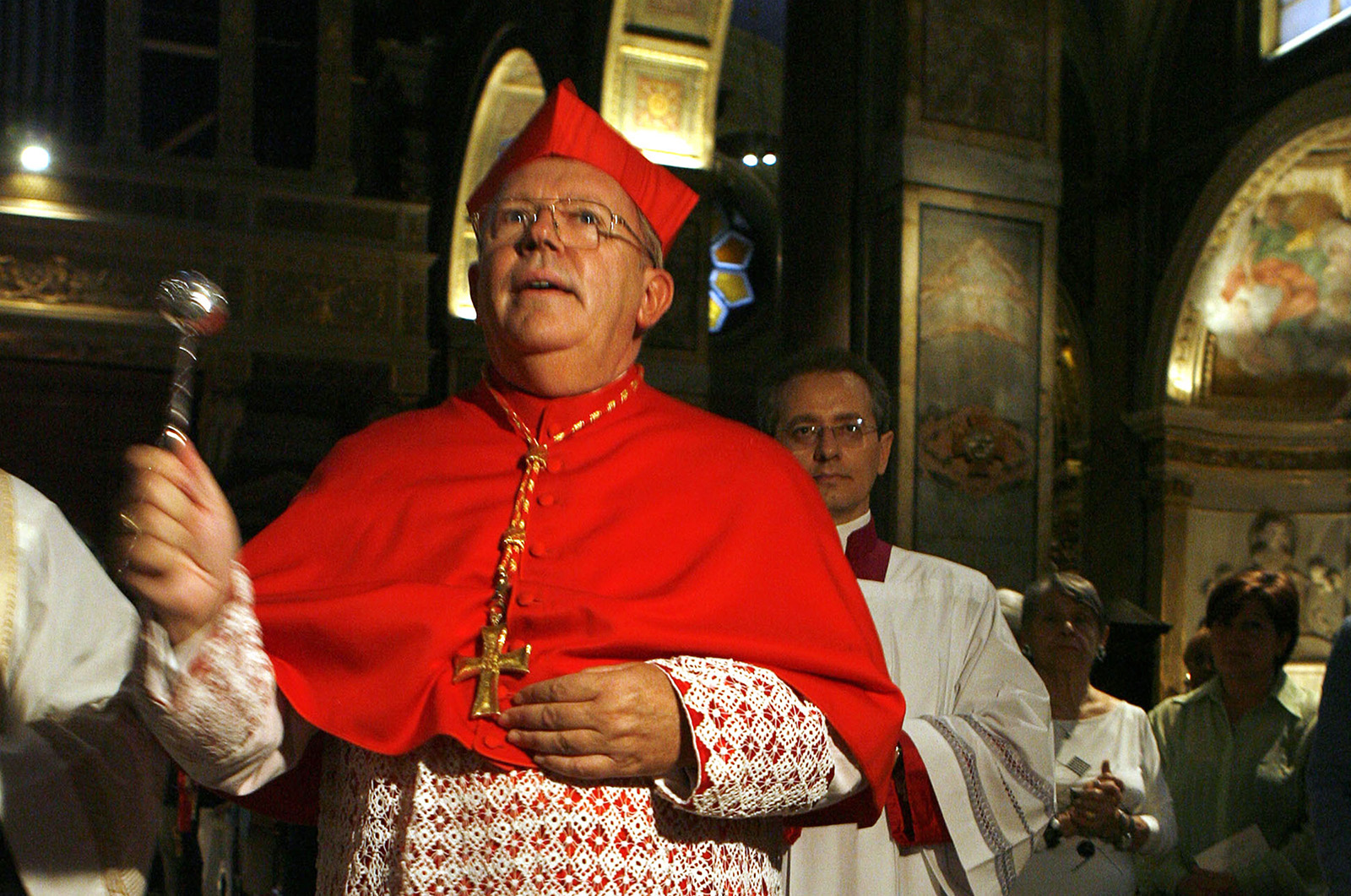
The archbishop of Bordeaux, France, Cardinal Jean-Pierre Bernard Ricard, blesses his titular church — Sant’ Agostino — during a ceremony to officially take possession of his church, in Rome, Oct. 8, 2006. Ricard said on Nov. 7, 2022, that he had abused a 14-year-old girl 35 years ago and is withdrawing from his functions. The move comes after a report issued last year revealed a large number of child sex abuse cases within the country’s Catholic Church. (AP Photo/Andrew Medichini, File)
Calls for an independent investigation of sexual abuse in Italy have been faced with vocal opposition by local bishops and the reports so far have fallen short of portraying abuse in the Catholic country.
As the year draws to a close, allegations of sexual abuse by Jesuit priest Marko Rupnik emerged and were acknowledged by the Society of Jesus. Rupnik, known for his mosaics and artwork all over the world, remained mostly unpunished after the allegations first emerged. The faltering response by the Jesuit society and the Vatican reveals the church’s ongoing struggle when it comes to accountability and transparency for sexual abuse.
Vatican reform: A never-ending story
A Vatican megatrial of 10 lay and religious individuals — tied to the purchase of a property in London’s Chelsea district that cost the institution over $200 million — gained momentum this year. The complicated financial trial has it all: rivalries among Vatican offices and prelates, espionage, love affairs, money laundering. Vatican prosecutors have maintained that a cast of shady Italian financiers colluded with Vatican prelates, including Cardinal Angelo Becciu, to use charitable funds for financial gains.
The judges watched as defendants accused one another of financial crimes and spiritual sins, until the Vatican prosecutors’ star witness, Monsignor Alberto Perlasca, stood on the stand in November unable to provide facts or evidence for the accusations. Once a key suspect in the investigations, Perlasca testified many times that he “cannot remember” many of the events that occurred, and Vatican judges warned him against perjuring himself.
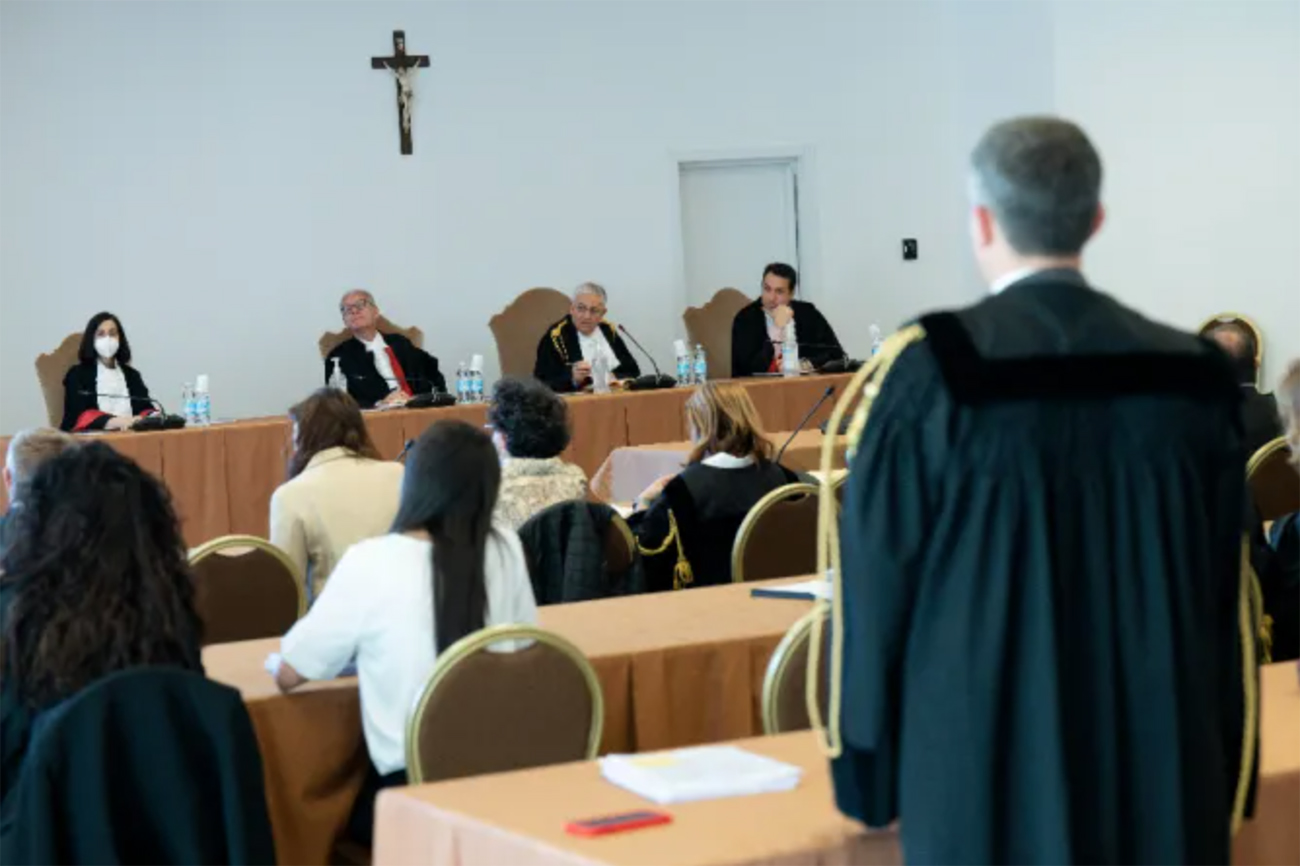
Proceedings in the Vatican finance trial on May 20, 2022. Photo by Vatican Media
The trial is now at a standstill, with more questions unanswered. Meanwhile, old grudges resurfaced, as former Vatican auditor Libero Milone attempted to sue the Vatican’s Secretariat of State for unjustly firing him in 2017.
Amid financial scandals, the Vatican warns its mission risks being underfunded. In March, Pope Francis finally released his apostolic constitution, “Praedicate Evangelium” (Peach the Gospel), which instituted the ethical requirements for Vatican investments and created new commissions for economic oversight.
The long-awaited document also enshrined the reform effort made so far in Vatican departments and opened the door for laypeople to become department heads in the Catholic institution. In a recent interview, Francis announced he intends to appoint a woman to head a Vatican department within the next three years.
